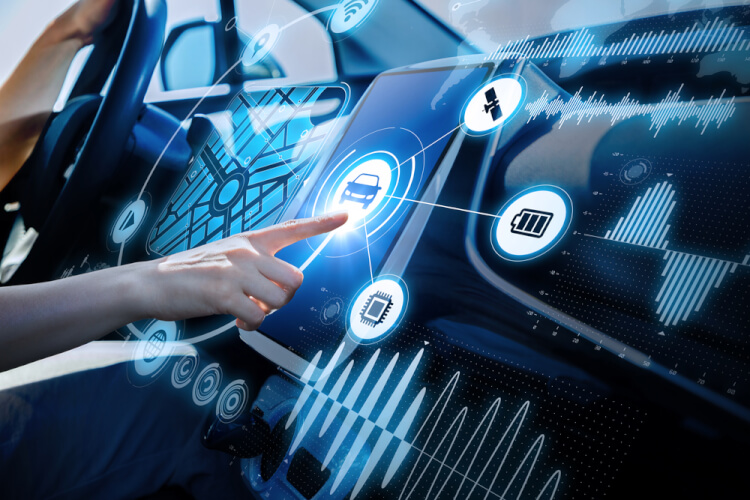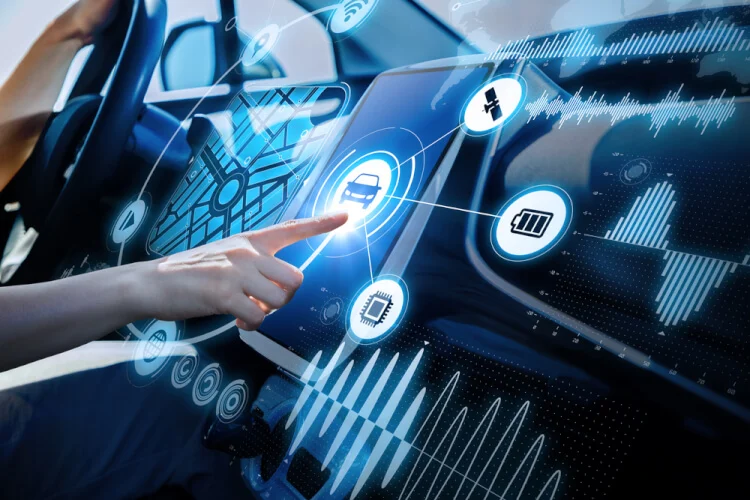IoT is currently attracting a lot of attention in the automotive industry . This article explains the basics of “What is IoT?”, the benefits of using IoT, and the challenges faced by its use. We will also introduce examples of actual use cases.

What is IoT?
IoT is an abbreviation for “Internet of Things” and refers to technology that interconnects not only computers and other communication devices but also various “things” around us through the Internet. Once IoT is realized, it will be possible to control, monitor, and analyze things. For example, you can operate home appliances from outside or display the temperature and humidity of your home on your device. In addition, it is expected that the data collected from a wide variety of things as IoT will be able to be used for more specific purposes by having it analyzed by AI.
Benefits of using IoT technology
There are various fields and companies considering the use of IoT, and the automotive industry is no exception. So, what are the specific benefits of introducing IoT into cars? Below are two main benefits.
Realization of autonomous driving
The most attention-grabbing aspect of IoT in automobiles is the realization of autonomous driving. By using IoT in cars, sensors installed inside the car collect information such as current location and driving data and send it to the cloud. Next, AI precisely analyzes the information sent to the cloud. The analyzed data is then sent to the car. Based on this data, cars will be able to perform safe automated driving that is more optimized for the current situation.
The benefits of autonomous driving go beyond reducing the burden on drivers. It will also help prevent accidents such as steering errors and drowsy driving, as well as alleviate traffic congestion. Automated driving will also be useful for elderly people to use cars safely and securely in regions where public transportation is scarce.
Self-driving cars may become a reality in the not-too-distant future. In Japan, since April 2020, Level 3 autonomous driving, which allows the system to take over the driving under certain conditions such as on expressways, has become possible. In the future, we will see Level 5 autonomous driving, where the driving is completely left to the system.
Companies can expect to improve engagement with customers
IoT is also useful for companies that provide automobiles to improve customer engagement. Customer engagement refers to the relationship of trust that is formed between customers and companies that provide products and services. In other words, the higher the engagement from customers, the more likely they will prioritize checking out your company’s products and services.
Now, by using IoT to collect and analyze each customer’s driving data, automobile companies can provide services tailored to each customer.
For example, it can detect the condition of a car and suggest maintenance at the optimal time. Or, from the accumulation of driving data, it can predict “when and which roads the customer will travel on” and provide real-time alerts regarding traffic information and weather.
In this way, more personalized services can be performed on a daily basis. It is highly anticipated that this will lead to sustained high levels of engagement from individual customers.
It is also important to utilize driver driving data for new car development and marketing. What kind of drivers, what elements, and in what situations do they seek them out? By accumulating and analyzing this information, we will be able to provide products and services of even higher quality.
Issues of concern due to the use of IoT technology
We introduced the benefits of using IoT in cars, such as realizing autonomous driving and strengthening customer engagement. However, there are still concerns regarding the use of IoT. In other words, solving these issues will lead to the adoption of IoT in the automobile industry.
The main issues of concern are explained below.
security issues
Automobiles that have become online due to IoT are at risk of being attacked by cyberattacks. It’s similar to when a computer gets infected with a virus or gets hacked. If a car were to be attacked by a cyberattack, it could cause malfunctions such as sudden braking, or in the worst case scenario, the attacker could take complete control of the vehicle. A malicious third party may attach unauthorized equipment to a vehicle and attempt an attack in a public parking lot where anyone can enter.
If a moving car were to be attacked by a cyberattack, it could cause serious damage. This is because there is a possibility that it may lead to a serious car accident and loss of life.
Furthermore, if an accident occurs due to a malfunction due to a cyber attack, it is not easy to determine who is responsible. If the culprit had erased the traces of the attack from the network, the fact that there had been a cyber attack would not have been recognized, and the blame could be attributed to driver error, product failure, etc. There is also.
IoT-enabled cars also look like regular cars. Therefore, drivers may have difficulty recognizing the need for security. However, in order to use autonomous driving safely and securely, it is necessary to have a strong security system that cannot be attacked.
infrastructure development
With the adoption of IoT in automobiles, a huge amount of data will be collected and used, including the driving data of thousands or tens of thousands of drivers, as well as road conditions, weather conditions, etc. The more data that is collected, and the more accurate it is, the more precise autonomous driving systems will become possible.
At the same time, it is essential to develop infrastructure such as base stations and networks to properly manage and share this information. Infrastructure security is also a major issue. If cybercrime is allowed to occur anywhere within a network that connects countless vehicles from various locations, it could lead to accidents on a much larger scale than individual car accidents. For these reasons, infrastructure development and security measures are essential.
Examples of IoT usage in automobiles
Automobiles are undergoing various evolutions due to IoT. Many companies are already competing to develop services that utilize IoT for automobiles. Here, we will introduce some typical usage examples.
Cooperation with wearable devices
As automobiles become IoT-enabled, collaboration with wearable devices such as smart watches is steadily being implemented. Overseas, it is already possible to share navigation system directions between a car and a smartwatch. When you set a destination on your smartwatch, the car will navigate you to the appropriate location, and the navigation will continue even when you walk after getting off the vehicle.
Furthermore, if you use a wearable device with a car-specific app installed, you can remotely adjust the air conditioner inside the car and lock/unlock the doors. Additionally, in the event that a vehicle is stolen, the system automatically connects to an operator and uses GPS to identify location information, leading to early detection.
In this way, there are already various usage examples of collaboration between IoT-enabled cars and wearable devices. We will continue to discover new ways to use this link with wearable devices.
Dispatch by robot taxi
DeNA and ZMP are jointly developing a robot taxi. A robot taxi is a self-driving taxi that can be called and used from a mobile device. Once you enter your destination and agree to the pricing, a self-driving taxi will arrive at your designated location. When you board the vehicle, the onboard camera recognizes you as a passenger and opens the door. Once you board the vehicle, it will automatically take you to your destination via the shortest route.
Robot taxis have the potential to become a means of transportation that allows foreign tourists visiting Japan who do not speak Japanese to easily and safely get around sightseeing spots. It is also expected to become a daily mode of transportation in areas where public transportation is lacking.
In addition, self-driving car dispatch services have also begun overseas. Currently, there is a driver on board just in case, but in the future it will be possible to provide services without a driver.
summary
IoT not only helps realize autonomous driving, but also collects driving data and improves customer engagement. As part of IoT, functions that link cars and wearable devices and the dispatch of robot taxis have already been realized. It can be said that the adoption of IoT in automobiles is steadily progressing towards becoming a reality, along with security measures and other measures.


